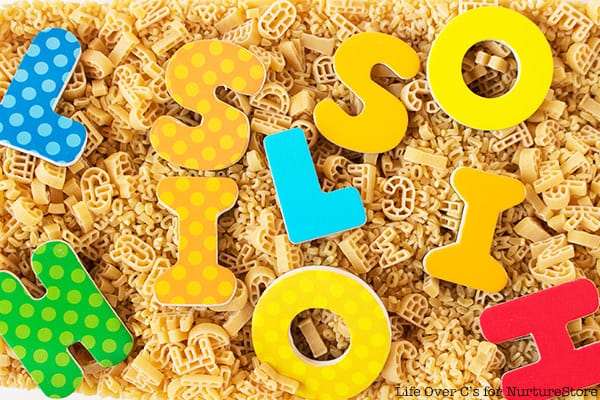I love this learn your name sensory bin that Kim from Life Over Cs is sharing as part of our ABCs and 123s letter and math activities. It’s great multi-sensory activity to introduce letters, and so adaptable.
Name Sensory Bin
>>>> Download our ABCs and 123s guide here
A name sensory bin is such a fun way to work on letters of names with preschoolers. It’s also simple to change for any name, so that every child can benefit from it.

You can use this name sensory bin to:
- Match letters in a child’s name
- Sort letters that are in/not in a name
- Find matching letters of the alphabet
- Trace letters to work on fine-motor skills
This sensory bin is very easy to prepare and can be used in so many ways to learn names, build letter recognition, practice letter sounds and even build simple words.

To assemble the sensory bin, fill a shoebox sized container halfway with alphabet pasta. We used two different sizes to add extra fun to the activity.
Add letters to the bin, such as, Melissa & Doug’s wooden letter magnets, alphabet puzzle pieces, or plastic letter magnets.
The downside to using the wooden letter magnets that we used is that they are all uppercase which you wouldn’t traditionally use to write a name.
However, children do need to learn both uppercase and lowercase letters, so using them in this way is another way to expose them to the letters. There are some puzzles that have lowercase letters, so if this is a concern to you, I recommend that you use those along with an uppercase letter to start the name.

To work on matching the letters of the name, write the child’s name at the top of a piece of paper and have the child hunt for the matching letters. For beginning learners, any order is fine, but for a child with more experience, encourage her to find the letters in the order that they are written to familiarize her with the actual spelling order of her name.

To sort the letters, we turned the page to the backside and drew a sorting table with the labels “In my name” and “Not in my name” and then sorted many of the letters in the sensory bin accordingly.
Other ways to use the name sensory bin:
Write the letters of the alphabet on a piece of paper and have the child hunt for the letters to match them on the page.
Select a letter from the sensory bin and for pre-writing practice have the child trace around the letter. This will not teach him the correct way to form a letter, but it does work on fine-motor skills which are needed for writing. You can also have him correctly form the letter inside the traced letter.
Trace the letters from the sensory bin and have the child decorate the letters with fun designs.
For a child who is ready to start forming simple words, you can write words on a paper and have them find the missing letters, sounding out the word as they do so.
Have the child select one of the large letters from the sensory bin and then hunt in the alphabet pasta for matching letters.
More ideas for hands-on letter games
This “Slippery Ice” name game is another fun way to work on letters of names.
We have also used the letter magnets to play Alphabet I Spy.
This fruits and vegetables matching sensory bin is another easy prep learning bin for preschoolers!
Want even more hands-on learning ideas? Follow Life Over C’s on Instagram for learning inspiration!
Kim is a work at home mom of four awesome daughters {12, 11, 8 year olds and a special needs 5 year old}. She is in her 8th year of homeschooling and, before recently returning to the United States, lived overseas for 9 years. Kim shares free printables, educational activities and family life on Life Over C’s.
ABCs and 123s : fun learning activities for letters and math
All our favourite literacy activities, all in one place :: download our ABCs and 123s guide here.




Great ideas- with one change… Please don’t teach your child to recognize and write worlds in all uppercase letters! Then teachers have to spend a large amount of time correcting this. Uppercase letters are not as common in print, so lowercase is more important. Their name should be learned with a capital first letter and lowercase for the rest. I know that uppercase letters are more available for magnets, wooden letters, etc., but it is important!
Yes, I agree. You’ll see that Kim addressed this issue in her article too.